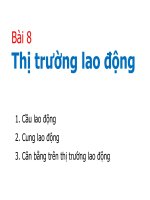- Trang chủ >>
- Đại cương >>
- Kinh tế vi mô
Monopoly and monosony (KINH tế VI mô SLIDE)
Bạn đang xem bản rút gọn của tài liệu. Xem và tải ngay bản đầy đủ của tài liệu tại đây (1.35 MB, 50 trang )
CHAPTER
10Market
Power:
Monopoly
and
Monopsony
Prepared by:
Fernando & Yvonn
Quijano
Copyright © 2009 Pearson Education, Inc. Publishing as Prentice Hall • Microeconomics • Pindyck/Rubinfeld, 8e.
Chapter 10: Market Power: Monopoly and Monopsony
CHAPTER 10 OUTLINE
10.1 Monopoly
10.2 Monopoly Power
10.3 Sources of Monopoly Power
10.4 The Social Costs of Monopoly Power
10.5 Monopsony
10.6 Monopsony Power
10.7 Limiting Market Power: The Antitrust Laws
Copyright © 2009 Pearson Education, Inc. Publishing as Prentice Hall • Microeconomics • Pindyck/Rubinfeld, 8e.
2 of 50
Chapter 10: Market Power: Monopoly and Monopsony
Market Power: Monopoly and Monopsony
● monopoly
● monopsony
Market with only one seller.
Market with only one buyer.
● market power Ability of a seller or buyer
to affect the price of a good.
Copyright © 2009 Pearson Education, Inc. Publishing as Prentice Hall • Microeconomics • Pindyck/Rubinfeld, 8e.
3 of 50
10.1
MONOPOLY
Chapter 10: Market Power: Monopoly and Monopsony
Average Revenue and Marginal Revenue
● marginal revenue
Change in revenue
resulting from a one-unit increase in output.
TABLE 10.1
Price (P)
(AR)$6
Total, Marginal, and Average Revenue
Quantity (Q)
Total
Revenue (R)
Marginal
Revenue (MR)
Average
Revenue
0
$0
---
---
5
1
5
$5
$5
4
2
8
3
4
3
3
9
1
3
2
4
8
-1
2
1
5
5
-3
1
Copyright © 2009 Pearson Education, Inc. Publishing as Prentice Hall • Microeconomics • Pindyck/Rubinfeld, 8e.
4 of 50
10.1
MONOPOLY
Average Revenue and Marginal Revenue
Chapter 10: Market Power: Monopoly and Monopsony
Figure 10.1
Average and Marginal
Revenue
Average and marginal
revenue are shown for
the demand curve
P = 6 − Q.
Copyright © 2009 Pearson Education, Inc. Publishing as Prentice Hall • Microeconomics • Pindyck/Rubinfeld, 8e.
5 of 50
10.1
MONOPOLY
The Monopolist’s Output Decision
Chapter 10: Market Power: Monopoly and Monopsony
Figure 10.2
Profit Is Maximized When Marginal
Revenue Equals Marginal Cost
Q* is the output level at which
MR = MC.
If the firm produces a smaller
output—say, Q1—it sacrifices
some profit because the extra
revenue that could be earned
from producing and selling the
units between Q1 and Q*
exceeds the cost of producing
them.
Similarly, expanding output from
Q* to Q2 would reduce profit
because the additional cost
would exceed the additional
revenue.
Copyright © 2009 Pearson Education, Inc. Publishing as Prentice Hall • Microeconomics • Pindyck/Rubinfeld, 8e.
6 of 50
10.1
MONOPOLY
Chapter 10: Market Power: Monopoly and Monopsony
The Monopolist’s Output Decision
We can also see algebraically that Q* maximizes profit. Profit π is the
difference between revenue and cost, both of which depend on Q:
As Q is increased from zero, profit will increase until it reaches a
maximum and then begin to decrease. Thus the profit-maximizing
Q is such that the incremental profit resulting from a small increase
in Q is just zero (i.e., Δπ /ΔQ = 0). Then
But ΔR/ΔQ is marginal revenue and ΔC/ΔQ is marginal cost. Thus
the profit-maximizing condition is that
, or
Copyright © 2009 Pearson Education, Inc. Publishing as Prentice Hall • Microeconomics • Pindyck/Rubinfeld, 8e.
7 of 50
10.1
MONOPOLY
An Example
Chapter 10: Market Power: Monopoly and Monopsony
Figure 10.3
Example of Profit Maximization
Part (a) shows total revenue R, total cost C,
and profit, the difference between the two.
Part (b) shows average and marginal
revenue and average and marginal cost.
Marginal revenue is the slope of the total
revenue curve, and marginal cost is the
slope of the total cost curve.
The profit-maximizing output is Q* = 10, the
point where marginal revenue equals
marginal cost.
At this output level, the slope of the profit
curve is zero, and the slopes of the total
revenue and total cost curves are equal.
The profit per unit is $15, the difference
between average revenue and average cost.
Because 10 units are produced, total profit
is $150.
Copyright © 2009 Pearson Education, Inc. Publishing as Prentice Hall • Microeconomics • Pindyck/Rubinfeld, 8e.
8 of 50
10.1
MONOPOLY
Chapter 10: Market Power: Monopoly and Monopsony
A Rule of Thumb for Pricing
We want to translate the condition that marginal revenue should
equal marginal cost into a rule of thumb that can be more easily
applied in practice.
To do this, we first write the expression for marginal revenue:
Copyright © 2009 Pearson Education, Inc. Publishing as Prentice Hall • Microeconomics • Pindyck/Rubinfeld, 8e.
9 of 50
10.1
MONOPOLY
Chapter 10: Market Power: Monopoly and Monopsony
A Rule of Thumb for Pricing
Note that the extra revenue from an incremental unit of quantity,
Δ(PQ)/ΔQ, has two components:
1. Producing one extra unit and selling it at price P brings in
revenue (1)(P) = P.
2. But because the firm faces a downward-sloping demand
curve, producing and selling this extra unit also results in a
small drop in price ΔP/ΔQ, which reduces the revenue from
all units sold (i.e., a change in revenue Q[ΔP/ΔQ]).
Thus,
Copyright © 2009 Pearson Education, Inc. Publishing as Prentice Hall • Microeconomics • Pindyck/Rubinfeld, 8e.
10 of 50
10.1
MONOPOLY
Chapter 10: Market Power: Monopoly and Monopsony
A Rule of Thumb for Pricing
(Q/P)(ΔP/ΔQ) is the reciprocal of the elasticity of demand,
1/Ed, measured at the profit-maximizing output, and
Now, because the firm’s objective is to maximize profit, we
can set marginal revenue equal to marginal cost:
which can be rearranged to give us
(10.1)
Equivalently, we can rearrange this equation to express
price directly as a markup over marginal cost:
(10.2)
Copyright © 2009 Pearson Education, Inc. Publishing as Prentice Hall • Microeconomics • Pindyck/Rubinfeld, 8e.
11 of 50
Chapter 10: Market Power: Monopoly and Monopsony
10.1
MONOPOLY
In 1995, Prilosec, represented a new generation of
antiulcer medication. Prilosec was based on a very
different biochemical mechanism and was much more
effective than earlier drugs.
By 1996, it had become the best-selling drug in the world and faced no
major competitor.
Astra-Merck was pricing Prilosec at about $3.50 per daily dose.
The marginal cost of producing and packaging Prilosec is only about 30 to
40 cents per daily dose.
The price elasticity of demand, ED, should be in the range of roughly −1.0 to
−1.2.
Setting the price at a markup exceeding 400 percent over marginal cost is
consistent with our rule of thumb for pricing.
Copyright © 2009 Pearson Education, Inc. Publishing as Prentice Hall • Microeconomics • Pindyck/Rubinfeld, 8e.
12 of 50
10.1
MONOPOLY
Chapter 10: Market Power: Monopoly and Monopsony
Shifts in Demand
A monopolistic market has no supply curve.
The reason is that the monopolist’s output decision depends not only
on marginal cost but also on the shape of the demand curve.
Shifts in demand can lead to changes in price with no change in
output, changes in output with no change in price, or changes in both
price and output.
Copyright © 2009 Pearson Education, Inc. Publishing as Prentice Hall • Microeconomics • Pindyck/Rubinfeld, 8e.
13 of 50
10.1
MONOPOLY
Shifts in Demand
Chapter 10: Market Power: Monopoly and Monopsony
Figure 10.4
Shifts in Demand
Shifting the demand curve shows
that a monopolistic market has no
supply curve—i.e., there is no
one-to-one relationship between
price and quantity produced.
In (a), the demand curve D1 shifts
to new demand curve D2.
But the new marginal revenue
curve MR2 intersects marginal
cost at the same point as the old
marginal revenue curve MR1.
The profit-maximizing output
therefore remains the same,
although price falls from P1 to P2.
In (b), the new marginal revenue
curve MR2 intersects marginal
cost at a higher output level Q2.
But because demand is now more
elastic, price remains the same.
Copyright © 2009 Pearson Education, Inc. Publishing as Prentice Hall • Microeconomics • Pindyck/Rubinfeld, 8e.
14 of 50
10.1
MONOPOLY
Chapter 10: Market Power: Monopoly and Monopsony
The Effect of a Tax
Suppose a specific tax of t dollars per unit is levied, so that the monopolist
must remit t dollars to the government for every unit it sells. If MC was the
firm’s original marginal cost, its optimal production decision is now given by
Figure 10.5
Effect of Excise Tax on Monopolist
With a tax t per unit, the firm’s
effective marginal cost is
increased by the amount t to
MC + t.
In this example, the increase in
price ΔP is larger than the tax t.
Copyright © 2009 Pearson Education, Inc. Publishing as Prentice Hall • Microeconomics • Pindyck/Rubinfeld, 8e.
15 of 50
10.1
MONOPOLY
Chapter 10: Market Power: Monopoly and Monopsony
The Multiplant Firm
Suppose a firm has two plants. What should its total output be, and how
much of that output should each plant produce? We can find the answer
intuitively in two steps.
● Step 1. Whatever the total output, it should be divided between
the two plants so that marginal cost is the same in each plant.
Otherwise, the firm could reduce its costs and increase its profit
by reallocating production.
● Step 2. We know that total output must be such that marginal
revenue equals marginal cost. Otherwise, the firm could increase
its profit by raising or lowering total output.
Copyright © 2009 Pearson Education, Inc. Publishing as Prentice Hall • Microeconomics • Pindyck/Rubinfeld, 8e.
16 of 50
10.1
MONOPOLY
Chapter 10: Market Power: Monopoly and Monopsony
The Multiplant Firm
We can also derive this result algebraically. Let Q1 and C1 be the output
and cost of production for Plant 1, Q2 and C2 be the output and cost of
production for Plant 2, and QT = Q1 + Q2 be total output. Then profit is
The firm should increase output from each plant until the incremental profit
from the last unit produced is zero. Start by setting incremental profit from
output at Plant 1 to zero:
Here Δ(PQT)/ΔQ1 is the revenue from producing and selling one more unit—
i.e., marginal revenue, MR, for all of the firm’s output.
Copyright © 2009 Pearson Education, Inc. Publishing as Prentice Hall • Microeconomics • Pindyck/Rubinfeld, 8e.
17 of 50
10.1
MONOPOLY
Chapter 10: Market Power: Monopoly and Monopsony
The Multiplant Firm
The next term, ΔC1/ΔQ1, is marginal cost at Plant 1, MC1. We thus have
MR − MC1 = 0, or
Similarly, we can set incremental profit from output at Plant 2 to zero,
Putting these relations together, we see that the firm should produce so that
(10.3)
Copyright © 2009 Pearson Education, Inc. Publishing as Prentice Hall • Microeconomics • Pindyck/Rubinfeld, 8e.
18 of 50
10.1
MONOPOLY
The Multiplant Firm
Chapter 10: Market Power: Monopoly and Monopsony
Figure 10.6
Production with Two Plants
A firm with two plants
maximizes profits by
choosing output levels Q1
and Q2 so that marginal
revenue MR (which
depends on total output)
equals marginal costs for
each plant, MC1 and MC2.
Copyright © 2009 Pearson Education, Inc. Publishing as Prentice Hall • Microeconomics • Pindyck/Rubinfeld, 8e.
19 of 50
10.2
MONOPOLY POWER
Figure 10.7
Chapter 10: Market Power: Monopoly and Monopsony
The Demand for Toothbrushes
Part (a) shows the market
demand for toothbrushes.
Part (b) shows the demand
for toothbrushes as seen by
Firm A.
At a market price of $1.50,
elasticity of market demand
is −1.5.
Firm A, however, sees a
much more elastic demand
curve DA because of
competition from other firms.
At a price of $1.50, Firm A’s
demand elasticity is −6.
Still, Firm A has some
monopoly power: Its profitmaximizing price is $1.50,
which exceeds marginal
cost.
Copyright © 2009 Pearson Education, Inc. Publishing as Prentice Hall • Microeconomics • Pindyck/Rubinfeld, 8e.
20 of 50
10.2
MONOPOLY POWER
Chapter 10: Market Power: Monopoly and Monopsony
Measuring Monopoly Power
Remember the important distinction between a perfectly competitive firm
and a firm with monopoly power: For the competitive firm, price equals
marginal cost; for the firm with monopoly power, price exceeds marginal
cost.
● Lerner Index of Monopoly Power
Measure of monopoly power calculated
as excess of price over marginal cost as
a fraction of price.
Mathematically:
This index of monopoly power can also be expressed in terms of the
elasticity of demand facing the firm.
(10.4)
Copyright © 2009 Pearson Education, Inc. Publishing as Prentice Hall • Microeconomics • Pindyck/Rubinfeld, 8e.
21 of 50
10.2
MONOPOLY POWER
Chapter 10: Market Power: Monopoly and Monopsony
The Rule of Thumb for Pricing
Figure 10.8
Elasticity of Demand and Price Markup
The markup (P − MC)/P is equal to minus the inverse of the elasticity of demand facing the firm.
If the firm’s demand is elastic, as in (a), the markup is small and the firm has little monopoly
power.
The opposite is true if demand is relatively inelastic, as in (b).
Copyright © 2009 Pearson Education, Inc. Publishing as Prentice Hall • Microeconomics • Pindyck/Rubinfeld, 8e.
22 of 50
Chapter 10: Market Power: Monopoly and Monopsony
10.2
MONOPOLY POWER
Although the elasticity of market demand for
food is small (about −1), no single supermarket
can raise its prices very much without losing
customers to other stores.
The elasticity of demand for any one
supermarket is often as large as −10. We find P
= MC/(1 − 0.1) = MC/(0.9) = (1.11)MC.
The manager of a typical supermarket should set prices about 11 percent
above marginal cost.
Small convenience stores typically charge higher prices because its customers
are generally less price sensitive.
Because the elasticity of demand for a convenience store is about −5, the
markup equation implies that its prices should be about 25 percent above
marginal cost.
With designer jeans, demand elasticities in the range of −2 to −3 are typical.
This means that price should be 50 to 100 percent higher than marginal cost.
Copyright © 2009 Pearson Education, Inc. Publishing as Prentice Hall • Microeconomics • Pindyck/Rubinfeld, 8e.
23 of 50
Chapter 10: Market Power: Monopoly and Monopsony
10.2
MONOPOLY POWER
TABLE 10.2
Retail Prices of VHS and DVDs
2007
1985
Title
Retail Price VHS
Title
Retail Price DVD
Purple Rain
$29.88
Pirates of the Caribbean
$19.99
Raiders of the Lost Ark
$24.95
The Da Vinci Code
$19.99
Jane Fonda Workout
$59.95
Mission: Impossible III
$17.99
The Empire Strikes Back
$79.98
King Kong
$19.98
An Officer and a Gentleman
$24.95
Harry Potter and the Goblet of Fire
$17.49
Star Trek: The Motion Picture
$24.95
Ice Age
$19.99
Star Wars
$39.98
The Devil Wears Prada
$17.99
Source (2007): Based on . Suggested retail price.
Copyright © 2009 Pearson Education, Inc. Publishing as Prentice Hall • Microeconomics • Pindyck/Rubinfeld, 8e.
24 of 50
Chapter 10: Market Power: Monopoly and Monopsony
10.2
MONOPOLY POWER
Figure 10.9
Video Sales
Between 1990 and 1998, lower
prices induced consumers to buy
many more videos.
By 2001, sales of DVDs overtook
sales of VHS videocassettes.
High-definition DVDs were
introduced in 2006, and are
expected to displace sales of
conventional DVDs.
Copyright © 2009 Pearson Education, Inc. Publishing as Prentice Hall • Microeconomics • Pindyck/Rubinfeld, 8e.
25 of 50









